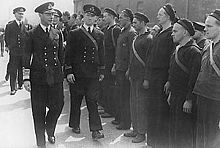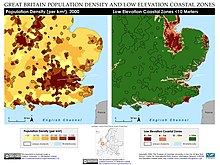Visit Portsmouth Place – things to do & explore
![]() Visit Portsmouth places on a day-trip, weekend away or holiday – and Walkfo becomes your personal digital tour guide to Portsmouth things to do.
Visit Portsmouth places on a day-trip, weekend away or holiday – and Walkfo becomes your personal digital tour guide to Portsmouth things to do.
Visiting Portsmouth Overview
Portsmouth is a port city in the ceremonial county of Hampshire in southern England . Located on Portsea Island, it is 70 miles (110 km) south-west of London and 19 miles south-east of Southampton . It has a population of 238,800, and is the only city in British Isles with a greater population density than London . The city’s history can be traced to Roman times and was England’s first line of defence during the French invasion in 1545 .
When you visit Portsmouth, Portsmouth history becomes available at the places you travel to by foot, bike, bus or car with a mobile phone & headphones.
Portsmouth places overview by Walkfo
Visit to Portsmouth stats
With 117 tourism audio plaques & places for you to explore in Portsmouth, Walkfo is the world’s largest heritage & history digital plaque provider in the world. Our AI continually learns & refines content about the best Portsmouth places to visit from online information authorities like Wikipedia for current & history, and converts it into an audio experience.
Portsmouth history
Early history
The city’s name, “Portesmuða”, is derived from port (a haven) and muða (the mouth of a large river or estuary) In the Anglo-Saxon Chronicle, a warrior named Port and his two sons killed a noble Briton in Portsmouth in 501 . The Romans built Portus Adurni, a fort, at nearby Portchester in the late third century .
Norman to Tudor

Portsmouth was founded in 1180 by the Anglo-Norman merchant Jean de Gisors . King Henry II died in 1189; his son, Richard I, arrived in Portsmouth en route to his coronation . Richard gave Portsmouth market-town status with a royal charter on 2 May, authorising an annual fifteen-day free-market fair, weekly markets and a local court to deal with minor matters . King John reaffirmed Richard I’s rights and privileges, and established a permanent naval base .
Stuart to Georgian

In 1623, Charles I (then Prince of Wales) returned to Portsmouth from France and Spain . His unpopular military adviser, George Villiers, 1st Duke of Buckingham, was stabbed to death in an Old Portsmouth pub by war veteran John Felton five years later . Most residents supported the parliamentarians during the English Civil War, although military governor Colonel Goring supported the royalists . After the Restoration, Charles II married Catherine of Braganza at the Royal Garrison Church .
Industrial Revolution to Edwardian

Marc Isambard Brunel established the world’s first mass-production line at Portsmouth Block Mills, making pulley blocks for rigging on the navy’s ships . The Royal Navy’s reliance on Portsmouth led to its becoming the most fortified city in the world . In 1900, Portsmouth Dockyard employed 8,000 people – a figure which increased to 23,000 during the First World War .
1913 terrorist attack

A major terrorist incident occurred in the city in 1913, which led to the deaths of two men . During the suffragette campaign of 1912–1914, militant suffragettes of the Women’s Social and Political Union carried out a series of politically motivated bombing and arson attacks nationwide as part of their campaign for women’s suffrage . In one of the more serious attacks, a fire was purposely started at Portsmouth dockyard in which 2 sailors were killed after it spread through the industrial area . The damage to the dockyard area cost the city £200,000 in damages, equivalent to £23,600,000 today .
First and Second World Wars

On 1 October 1916, Portsmouth was bombed by a Zeppelin airship . During the Second World War, the city (particularly the port) was bombed extensively by the Luftwaffe . Portsmouth experienced 67 air raids between July 1940 and May 1944, which destroyed 6,625 houses and severely damaged 6,549 . Portsmouth Harbour was a vital military embarkation point for the 6 June 1944 D-Day landings .
1945 to present
Much of the city’s housing stock was damaged during the war . More than 700 prefab houses were constructed between 1945 and 1947, some over bomb sites . Shipbuilding jobs fell from 46 percent of the workforce in 1951 to 14 per cent in 1966, drastically reducing manpower in the dockyard . A controversial decision was made to replace a section of the central city with council housing during the 1960s and early 1970s .
Portsmouth culture & places
Portsmouth has three musical venues: the Guildhall, the Wedgewood Rooms, and Portsmouth Pyramids Centre. H.M.S. Pinafore is a comic opera in two acts set in Portsmouth Harbour. A number of musical works are set in the city. The annual Portsmouth International Kite Festival celebrated its 25th anniversary in 2016.
Portsmouth landmarks

Most of the city’s landmarks and tourist attractions are related to its naval history. Horatio Nelson’s flagship HMS Victory, the world’s oldest naval ship still in commission, is in the dry dock of Portsmouth Historic Dockyard. The birthplace of Charles Dickens, at Mile End Terrace, is the Charles Dickens’ Birthplace Museum.
Portsmouth geography / climate

Portsmouth is 73.5 miles (118.3 km) by road from central London. It is located primarily on Portsea Island and is the United Kingdom’s only island city. Gosport is a borough to the west; Old Portsmouth is in the south-west part of the island.
Climate
Portsmouth has a mild oceanic climate with more sunshine than most of the British Isles . Frosts are light and short-lived and snow is rare in winter, with temperatures rarely dropping below freezing . The city gets about 645 millimetres (25.4 in) of rain annually, with a minimum of 1 mm (0.04 in) reported 103 days per year .
When you visit Portsmouth
You can visit Portsmouth places and use Walkfo Portsmouth to discover the history & things to do in Portsmouth whilst walking with our free digital tour app. Walkfo Portsmouth has 117 places on our Portsmouth map with history, culture & travel facts that you explore the same way you would at a museum or art gallery with information audio headset. With Walkfo, you can travel by foot, bike or bus throughout Portsmouth, being in the moment, without digital distraction or limits to a specific walking route – you choose where you want to go, when you want to go and Walkfo Portsmouth will keep up.![]()
–
With millions of places including tourist walks, Portsmouth travel destinations, National Trust locations converted to audio experiences, our Portsmouth places AI guide will help you get the best from your visit to Portsmouth & the surrounding areas. The Portsmouth places app for iPhone & Android delivers hidden history, interesting culture and amazing facts in interactive audio stories in response to where you walk at National Heritage sites, tourist attractions, historic locations or city streets, with no predefined walk map requirements.
“The Walkfo AI has curated content for millions of locations across the UK, with 117 audio facts unique to Portsmouth places forming an interactive Portsmouth map for you to explore.”
Walkfo’s Visit Portsmouth Places Map
117 tourist, history, culture & geography spots
Portsmouth historic spot | Portsmouth tourist destination | Portsmouth plaque | Portsmouth geographic feature |
| Walkfo Portsmouth tourism map key: places to see & visit like National Trust sites, Blue Plaques, English Heritage locations & top tourist destinations in Portsmouth | |||
Best Portsmouth places to visit
Portsmouth has many places to explore by foot, bike or bus. Below are a selection of the varied Portsmouth’s destinations you can visit with additional content available at the Walkfo Portsmouth’s information audio spots:
 | The Bridge Shopping Centre (Portsmouth) The Bridge Shopping Centre is a small shopping centre located in Portsmouth, England . The centre was opened in May 1989 on land which was formerly home to Portsea Island Central Premises Co-Op . |
 | Portsmouth Block Mills The Portsmouth Block Mills were built during the Napoleonic Wars to supply the British Royal Navy with pulley blocks . They started the age of mass-production using all-metal machine tools and are regarded as one of the seminal buildings of the British Industrial Revolution . |
 | Tipner Tipner is a residential district of Portsmouth, located on the north western corner of Portsea Island . It includes a housing estate, built during the 1930s, that used to function as married quarters for the Royal Navy . It is bounded to the north and west by the M275 motorway and Tipner Lake . |
 | Fort Widley Fort Widley is one of the forts built on top of Portsdown Hill between 1860 and 1868. It was designed to protect Portsmouth from attack from the rear. |
 | Hilsea Hilsea is a district of the city of Portsmouth in the English county of Hampshire. Located at the northern end of Portsea Island, for most of its history Hilsea was a small hamlet on the Portsmouth to London road. The name “Hilsea” probably means ‘holly island’ The last working farm in Portsmouth was located in the area up to the 1990s. |
 | Hilsea Lines Hilsea Lines are a line of 18th- and 19th-century fortifications built at Hilsea to protect the northern approach to Portsea Island, an island off the southern coast of England. They are now used as a greenspace and leisure area, also known locally as Foxes Forest. |
 | Mountbatten Centre The Mountbatten Centre is a leisure centre in Portsmouth, England, which opened in 1979. It is located in Hilsea, an area in Portsmouth. |
 | Portsmouth Historic Dockyard Portsmouth Historic Dockyard is an area of HM Naval Base Portsmouth which is open to the public. It contains several historic buildings and ships. It is managed by the National Museum of the Royal Navy. |
Visit Portsmouth plaques
![]() 43
43
plaques
here Portsmouth has 43 physical plaques within tourist plaque schemes for you to explore via Walkfo Portsmouth plaques when visiting. Plaque schemes such as National Heritage’s “Blue Plaques” provide visual geo-markers to highlight points-of-interest at the places where they happened. Where a plaque is available, Walkfo AI has done research to provide additional, deeper content when you visit Portsmouth using the app. Experience hidden history & stories at each location as the Walkfo local tourist guide app uses trigger audio close to each Portsmouth plaque. Explore Portsmouth Plaques & History has a complete list of Hartlepool’s plaques & Hartlepool history plaque map.


